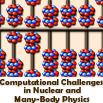Speaker
Örs Legeza
Description
Strongly correlated materials are typically rather difficult
to treat theoretically. They have a complicated band
structure, and it is quite difficult to determine which
minimal model correctly describes their essential physical
properties. Moreover, the value of the model parameters to
be used for a given material is often the subject of debate.
Unfortunately, analytic approaches often do not provide
rigorous conclusions for the interesting parameter sets,
therefore, numerical simulations are mandatory.
Momentum-space formulations of local models such as the
Hubbard model and problems in quantum chemistry are
especially hard to treat using matrix- and tensor
product-based algorithms because they contain non-local
interactions. Quantum entropy-based measures can be used
to map the entanglement structure in order to gain physical
information and to optimize algorithms.
In this tutorial contribution, we present an overview of the
real space, momentum space and quantum chemistry versions of
the DMRG/MPS and tree-TNS algorithms and their applications
to various spin and fermionic lattice models, and to
transition metal complexes. Data sparse representation of
the wavefunction will be investigated through advances in
entanglement localization providing optimized tensor
topologies. Entropy generation by the RG procedure, the
mutual information leading to a multiply connected network
of lattice sites or orbitals, and reduction of entanglement
by basis transformation will be discussed. Inclusion of the
concepts of entanglement will be used to identify the wave
vector of soft modes in critical models, to determine highly
correlated molecular orbitals leading to an efficient
construction of active spaces and for characterizing the
various types of correlation effects relevant for chemical
bonding.
The state of the art matrix-product-based algorithms is
demonstrated on polydiacetylene chains by reproducing
experimentally measured quantities with high accuracy.
[1] S. R. White, Phys. Rev. Lett. 69, 2863-2866 (1992).
[2] S. R. White and R. L. Martin, J. Chem. Phys. 110,
4127-4130 (1999).
[3] O. Legeza, R. M. Noack, J. SĂłlyom, and L. Tincani, in
Computational Many-Particle Physics, eds. H. Fehske, R.
Schneider, and A. Weisse 739, 653-664 (2008).
[4] K. H. Marti and M. Reiher, Z. Phys. Chem. 224, 583-599
(2010).
[5] G. K.-L. Chan and S. Sharma, Annu. Rev. Phys. Chem. 62,
465-481 (2011).
[6] O. Legeza and J. SĂłlyom, Phys. Rev. B 68, 195116
(2003), ibid Phys Rev. B 70, 205118 (2004).
[7] J. Rissler, R.M.Noack, and S.R. White, Chemical Physics,
323, 519 (2006).
[8] K. Boguslawski, P. Tecmer, O. Legeza, and M. Reiher, J.
Phys. Chem. Lett. 3, 3129-3135 (2012).
[9] K. Boguslawski, P. Tecmer, G. Barcza, O. Legeza, and M.
Reiher, J. Chem. Theory Comp. (2013).
[10] F. Verstraete, J.I. Cirac, V. Murg, Adv. Phys. 57 (2),
143 (2008).
[11] V. Murg, F. Verstraete, O. Legeza, and R. M. Noack,
Phys. Rev. B 82, 205105 (2010).
[12] V. Murg, F. Verstraete, R. Schneider, P. Nagy and O.
Legeza, arxiv:1403.0981 (2014).
[13] G. Barcza, O. Legeza, K. H. Marti, and M. Reiher, Phys.
Rev. A 83, 012508 (2011).
[14] G. Barcza, R. M. Noack, J. SĂłlyom, O. Legeza,
arxiv:1406.6643 (2014)

